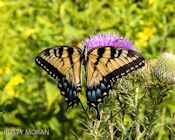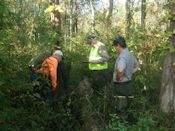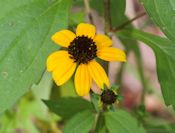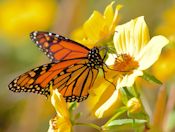In the spring, summer and fall of 2017, a team of volunteers conducted regular surveys of Lepidoptera (butterflies, moths and skippers) and Odonata (dragonflies and damselflies) in the Dyke Marsh Wildlife Preserve. Here are a few examples of their sightings:
Since 2015, working with the National Park Service, FODM has been trying to save some of the pumpkin ash trees (Fraxinus profunda) of the marsh that are being attacked by the invasive, lethal insect, the emerald ash borer (Agrilus planipennis) (See our longer article in “Marsh Life”).
Several people observed brown-eyed Susans (Rudbeckia triloba) this summer, 2017, along the Haul Road. It appears to be a new species of Rudbeckia for Dyke Marsh and this is the first photographic record of the species on George Washington Memorial Parkway (GWMP) properties. The plant was last observed in GWMP in Great Falls Park in 1919.
In the fall of 2017, the last generation of eastern monarch butterflies (Danaus plexippus) is migrating southwest to the mountains of central Mexico. Some of the butterflies are stopping to sip nectar from the masses of smooth beggartick blossoms blooming in Dyke Marsh.
On September 23, 2017, FODMers joined Northern Virginia Conservation Trust (NVCT) and Porto Vecchio volunteers on a kayak and canoe trash cleanup of NVCT’s newest property, a two-acre wetland at the confluence of Cameron Run and Hunting Creek on Alexandria’s southern border, just north of Dyke Marsh. The tidal wetlands, under the Beltway/I-95 ramps and elevated highways, are favorite sites for roosting gulls, migrating shorebirds and other birds, especially at low tide, an eBird “hotspot.”






